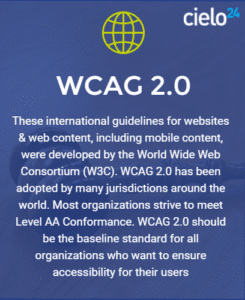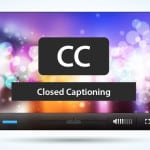
Guide to Captioning for WCAG 2.0 Compliance
Captioning for WCAG 2.0 Compliance
The Web Content Accessibility Guidelines 2.0 define measurable guidelines for giving all users equal access to information and functionality on the web. For users with hearing disabilities, captions are a must. This post will walk you through captioning for WCAG 2.0 compliance, along with the other requirements for time-based media.
The 4 Four Principles of WCAG

At the highest level, the WCAG 2.0 has four guiding principles:
- Perceivable – Users must be able to perceive the information being presented without any information being invisible to all of their senses.
- Operable – The user must be able to operate the interface.
- Understandable – Users must be able to understand the information and the operation of the interface.
- Robust – Content must be accessible by users and a wide variety of user agents.
These four principles are broken down into a total of 12 specific guidelines. Each of these guidelines has testable success criteria with a level of conformance ranging from A to AAA. Conformance level A is the minimum and AAA the highest.
Captioning for WCAG 2.0 Compliance: The Rules
Guideline 1.2 under Principle 1 covers the requirements for time-based media, including captions and audio description. Captioning for WCAG 2.0 is simple when you know the following requirements.
1.2.1 Audio-only and Video-only (Prerecorded): For prerecorded audio-only and prerecorded video-only media, the following are true, except when the audio or video is a media alternative for text and is clearly labeled as such: (Level A)
- Prerecorded Audio-only: An alternative for time-based media is provided that presents equivalent information for prerecorded audio-only content.
- Prerecorded Video-only: Either an alternative for time-based media or an audio track is provided that presents equivalent information for prerecorded video-only content.
 1.2.2 Captions (Prerecorded): Captions are provided for all prerecorded audio content in synchronized media, except when the media is a media alternative for text and is clearly labeled as such. (Level A). They can be open or closed captions. Find details on how to meet this requirement here.
1.2.2 Captions (Prerecorded): Captions are provided for all prerecorded audio content in synchronized media, except when the media is a media alternative for text and is clearly labeled as such. (Level A). They can be open or closed captions. Find details on how to meet this requirement here.
1.2.3 Audio Description or Media Alternative (Prerecorded): An alternative for time-based media or audio description of the prerecorded video content is provided for synchronized media, except when the media is a media alternative for text and is clearly labeled as such. (Level A)
1.2.4 Captions (Live): Captions are provided for all live audio content in synchronized media. (Level AA) 1.2.5 Audio Description (Prerecorded): Audio description is provided for all prerecorded video content in synchronized media. (Level AA)
1.2.5 Audio Description (Prerecorded): Audio description is provided for all prerecorded video content in synchronized media. (Level AA)
1.2.6 Sign Language (Prerecorded): Sign language interpretation is provided for all prerecorded audio content in synchronized media. (Level AAA)
1.2.7 Extended Audio Description (Prerecorded): Where pauses in foreground audio are insufficient to allow audio descriptions to convey the sense of the video, extended audio description is provided for all prerecorded video content in synchronized media. (Level AAA)
1.2.8 Media Alternative (Prerecorded): An alternative for time-based media is provided for all prerecorded synchronized media and for all prerecorded video-only media. (Level AAA)
1.2.9 Audio-only (Live): An alternative for time-based media that presents equivalent information for live audio-only content is provided. (Level AAA)
Who Benefits from WCAG Compliance?
Captioning for WCAG 2.0 compliance is important for users with disabilities, as well those without. People who are unable to hear or see online content need captions, transcripts, and audio descriptions to access the content. In addition, many people watch videos in environments where they can’t turn up the volume, and others have difficulty processing auditory components. For example, the elderly can have problems with understanding enunciation at any volume level and therefore may rely on captioning for clarity.
Research shows that captioning benefits all children, regardless of hearing ability. Students who watched captioned content experienced improved learning outcomes with increased comprehension and literacy.
Many users simply prefer to read a transcript in place of watching a video or listening to audio. In certain situations, viewing a video or listening to audio may not be appropriate or even possible. Additionally, a transcript allows a user to more easily quote or refer to information from the time-based media. Overall, captions in conjunction with transcripts can lead to more comprehensible content and higher user satisfaction.
Importance of WCAG
Implications of the WCAG 2.0 are numerous. From an ethical standpoint, the guidelines are a way of ensuring all users, regardless of disability or limitation, have appropriate access to web content. At the professional or business level, complying with the guidelines is a means to commercial success. And finally, from the legal stance, unwitting or blatant denial of the guidelines can lead to merited action against a company or institution for discrimination.
Currently, the DOJ, who enforces the ADA, requires WCAG 2.0 level AA compliance and many other federal and state laws, such as Section 508, require the same level of WCAG compliance. If you are involved in media broadcasting and entertainment, stay tuned for our next post on how to meet the FCC captioning rules.



